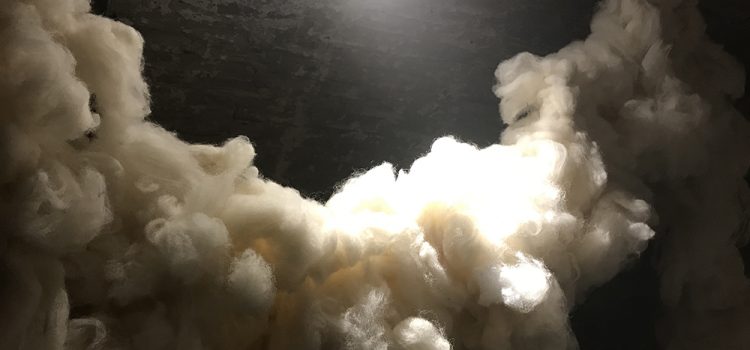
Today was a mystery tour through an area I know so well, Bloomsbury. And yet it turned out that there was so much I’d never seen. A story garden, magical spells, ghost stories and mysterious clouds in a crypt.
The day began in Ossulston Street. This is where you’ll find the socially-distanced queue for the British Library. I was early, so wandered up the road and came across the Story Garden. Look through large portholes in the turquoise hoardings and you see a community garden full of raised beds.
So unexpected, just off the Euston Road, between the British Library and the Francis Crick Institute, and a delightful start to the day.
Under coronavirus, the British Library is disquietingly quiet. No crowds bustling in and out, no cafes full of people on laptops, no queues for the exhibitions. On the plus side, you have the place pretty much to yourself.
The Hebrew Manuscripts exhibition was a revelation. One room filled with treasures, it is lit with twinkling lights that shed stars on ancient scrolls and parchment. The exhibition traces the story of the Jewish diaspora across the centuries through the written word. In 1530, a Rabbi in Modena tells Henry VIII’s advisors that the king can’t annul his marriage to Catherine of Aragon on biblical grounds. A 15th century Italian manuscript shows the Guidonian hand – a Mediaeval method of learning musical notes, and a 17th century Moroccan manuscript offers an alchemical recipe for gold.
By far my favourite, though, was a magical manual from Amsterdam that dated from 1700. In addition to providing spells on how to become invisible or frighten away your enemies, it explained how to escape from prison. Simply draw a boat on the floor, step into it and spirits will appear and carry you out.
From the British Library, I travelled to the Dickens Museum in Doughty Street. This was the starting point for an audio tour of Haunted Bloomsbury by Dr Romany Reagan, an audio walking artist and cemetery historian.
Dr Reagan was a very entertaining host, recounting stories of spiritualism and occult phenomena in Bloomsbury through the ages.
She described the day in 1871 when the medium Agnes Guppy-Volckman was at her home in Highbury Hill writing out a shopping list when she was suddenly astrally transported to a seance table at 61 Lamb’s Conduit Street. When she landed, she was still holding the shopping list where she was in the middle of writing the word ‘onions’.
I was also fascinated by the story of the Field of Forty Footsteps, where two brothers killed each other in a duel in a Bloomsbury meadow over 200 years ago. Apparently no grass would grow on the ground where the brothers had left their footsteps.
Continuing the sepulchral theme, my final stop of the day was The Crypt Gallery beneath St Pancras Church on Euston Road. The church is notable for the Greek-style caryatids who spend their lives holding up the portico in front and watching the buses go by. Right now, they’re probably also diverted by the HS2 protesters who’ve set up camp in the trees outside Euston Station.
In the crypt of the church, Sara Coppa and Paolo di Gennaro, two MA students from nearby Central St Martins, have set up an installation. The pair have created an intriguing environment that encourages us to embrace the joy of failure. At the beginning, a hand-written panel calls on us to: “Enter a tangle of memory to uncover how our hidden failures can eventually form and enhance our lives.”
As you progress through the small vaulted rooms of the crypt, you weave in and around cat’s cradle style threads and come across a breath-taking room full of clouds. In fact, they’re sheep’s wool, but even in these ‘look don’t touch’ days, it’s hard to resist stroking the clouds.
I loved my day out of time at the Bloomsbury Festival. It gave me stars and spells, occult stories and the touch of lanolin on my skin.
Photo: Sheep Clouds from Rooting Failure by Paolo Di Gennaro and Sara Coppa
> Return to 26 Writers in Residence homepage
